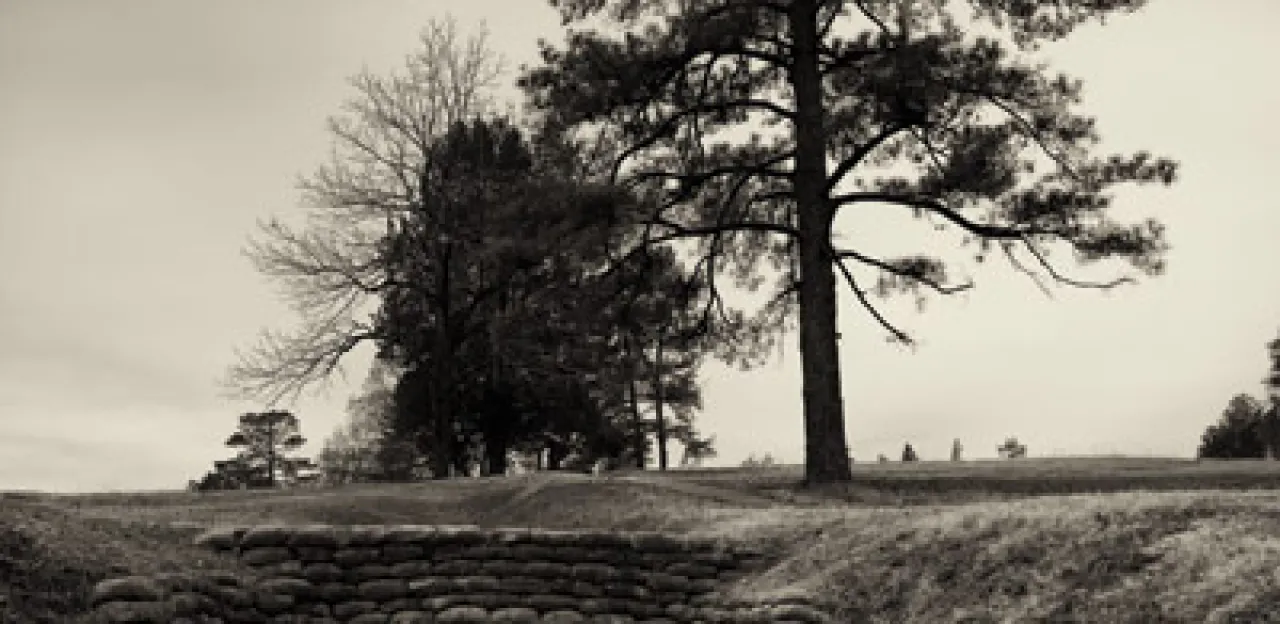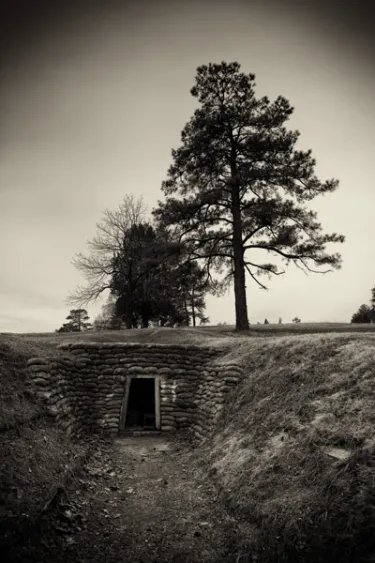Chaos Beyond the Crater

In early June 1864, reeling from the slaughter of the Overland Campaign, Union and Confederate armies began to concentrate at Petersburg, Va. Were the Federals to capture Petersburg and its critical rail lines, they would stop the manufacture and transportation of goods critical to the Confederacy. The location was also considered the “back door” to Richmond, located 25 miles to the north.
On June 9, some 1,400 Federal cavalrymen attacked a portion of the earthworks that had been constructed around Petersburg mostly by black men, enslaved and free. Defending that sector of the line were about 125 local militiamen composed of teenagers, men over the age of 50 and others exempted from military service. Although the militia was overrun in what became known as the Battle of Old Men and Young Boys, the arrival of Confederate reinforcements and the Union infantry’s failure to attack, led ultimately to a Federal defeat.
At 7:00 p.m. on June 15, 1864, Maj. Gen. William Smith’s XVIII Corps of the Army of the James, which included two divisions of white soldiers and one division of U.S. Colored Troops (or USCTs) attacked the 2,200 Southerners defending the city. The Federals captured a mile and a half of the earthworks by 9:00 p.m., but although Maj. Gen. Winfield Hancock’s II Corps had arrived at the scene, Smith halted any further assaults. He later reasoned, “I knew nothing of the country in front. My white troops were exhausted by marching day and night, and by fighting most of the day in the excessive heat. My colored troops, who had fought bravely, were intoxicated by their success, and could hardly be kept in order.” Overnight, Confederate Gen. P.G.T. Beauregard brought more troops to the vicinity and dug a new line of fortifications.

Over the next two days, Beauregard’s forces held back a series of poorly executed assaults from an ever-growing Federal host. Overnight on June 17–18, the Confederates fell back, dangerously close to Petersburg and set up another line of earthworks. The situation looked dire, as Beauregard issued a final plea to Gen. Robert E. Lee so urgent that staff officers roused the commander from his sleep. Finally, the Army of Northern Virginia began to arrive on June 18. The fighting that day concluded as both sides dug in. In just four days, more than 11,000 casualties were accumulated.
The experience in the trenches was harrowing; sharpshooters’ bullets and bursting mortar shells combined with drought and intense heat to create a true recipe for misery. Still the fighting went on.
On June 22 and 23, Southern Maj. Gen. William Mahone launched a two-day assault against Union forces along Jerusalem Plank Road, inflicting 2,600 casualties, most of whom were captured. Simultaneously, Federal cavalry led by Brig. Gens. James Wilson and August Kautz went on a raid against the Weldon, South Side and Richmond & Danville Railroads. Confederate cavalry and militia forces confronted them before the horsemen returned to Union lines by July 1.
Between June 25 and July 26, the 48th Pennsylvania Infantry of Maj. Gen Ambrose Burnside’s IX Corps dug a mine stretching more than 500 feet under the Confederate lines at a position called Elliott’s Salient. Burnside planned to pack the mine with 8,000 pounds of gunpowder and, after the explosion, have his division of black soldiers to take the high ground at Blandford Cemetery. However, Burnside’s plan was changed by Army of the Potomac commander Maj. Gen. George Meade — and confirmed by Lt. Gen. Ulysses Grant — prior to the attack.
The explosion occurred early on July 30, but the veteran white soldiers who rushed forward soon became entangled in the 170-foot-long, 60- to 80-foot-wide and 30-foot-deep hole crater, and suffered a severe artillery bombardment. The African-American soldiers entered the fray around 8:30 a.m. screaming “No Quarter,” in retaliation for the perceived massacre of black troops at the Battle of Fort Pillow. They were also incensed by Confederate laws that called for USCTs to be treated slaves acting in insurrection and their white officers as having incited it. A Mahone-led counterattack led to dramatic hand-to-hand combat. Troops of both sides turned their muskets into clubs, even as men were bayonetted and shot at point-blank range. The particular rage exhibited by Confederates confronted with the sight of armed black men was recalled years later by Petersburg resident George Bernard of the 12th Virginia Infantry, who remembered that the Southerners were “infuriated at the idea of having to fight negroes.” Another local, Robert Banks, had escaped slavery and served in the 23rd USCT. During the battle, he was struck in the head by a sword and shot in both arms. In 1887 he testified that, “My wounds have troubled me all along now and then since the war.” The Federals lost 3,826 men and the Confederates about 1,500.
Throughout the campaign, the Federal supply base was located at City Point (now Hopewell), Va. Generally, this was a safe location, but on August 9, 1864, Confederate secret service operative John Maxwell used a “horological torpedo,” or time bomb, to try and dislodge Grant. The blast damaged half of the wharf, but it was rebuilt within weeks.
The next battle occurred south of the city on August 18, 19, and 21. Southern troops in Lt. Gen. A.P. Hill’s Third Corps and Federal forces in Maj. Gen. Gouverneur K. Warren’s V Corps and elements of the IX Corps wrestled for control of the Weldon Railroad. Confederate desperation to maintain this line, which connected Petersburg and Richmond with Wilmington, N.C., was summed up by Meade’s staff officer Theodore Lyman, who wrote, “It is touching a tiger’s cubs to get on that road!” In what was becoming a familiar component of their service, Warren’s soldiers built earthworks and cut the railroad. A few days later, on August 25, Hill’s troops and Maj. Gen. Wade Hampton’s cavalry attacked Hancock’s II Corps at Reams Station along the Weldon Railroad, south of Warren’s position. The resulting Confederate victory here shattered Hancock’s corps. Supplies from North Carolina traveled on the Weldon line to Stony Creek Depot, south of Petersburg, and were then carted by wagons over the Boydton Plank Road into Petersburg.
Despite the assertion that the South was destined for defeat after Gettysburg, a year later, many Confederate soldiers continued to be convinced they would be victorious, given the Federals’ failure to capture Atlanta, Petersburg and Richmond. As the stalemate at Petersburg moved toward its third month, President Lincoln wrote on August 23, “It seems exceedingly probably [sic] that this Administration will not be re-elected.”
Related Battles
8,150
3,236






